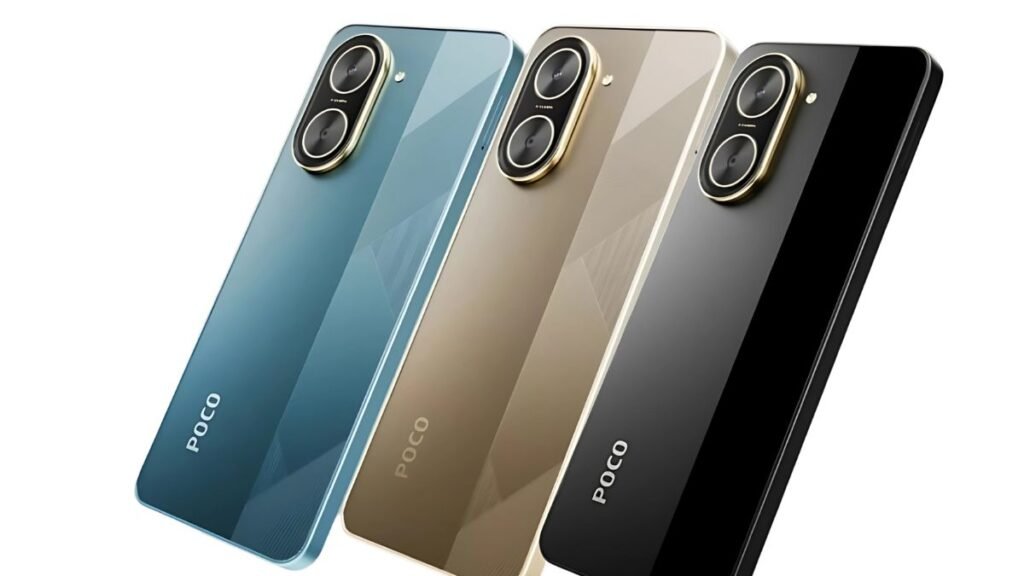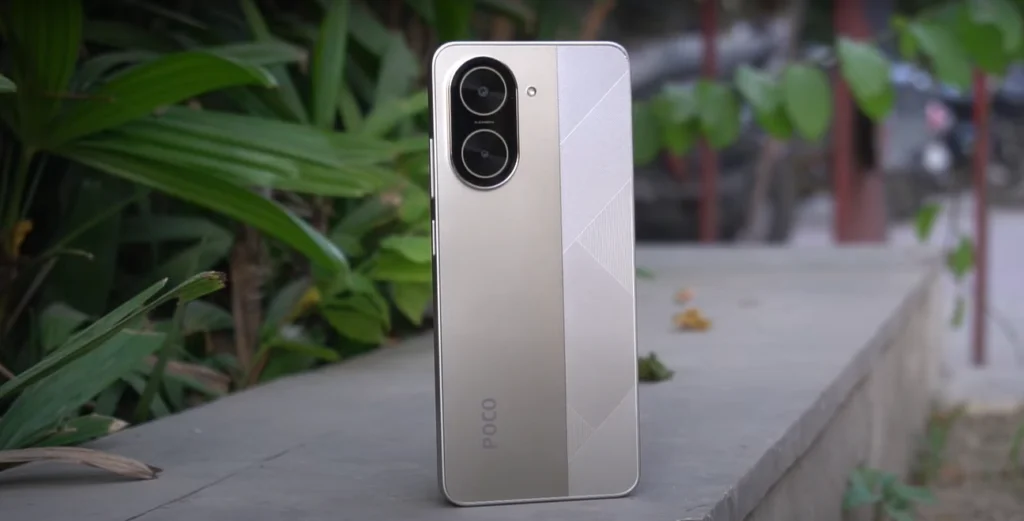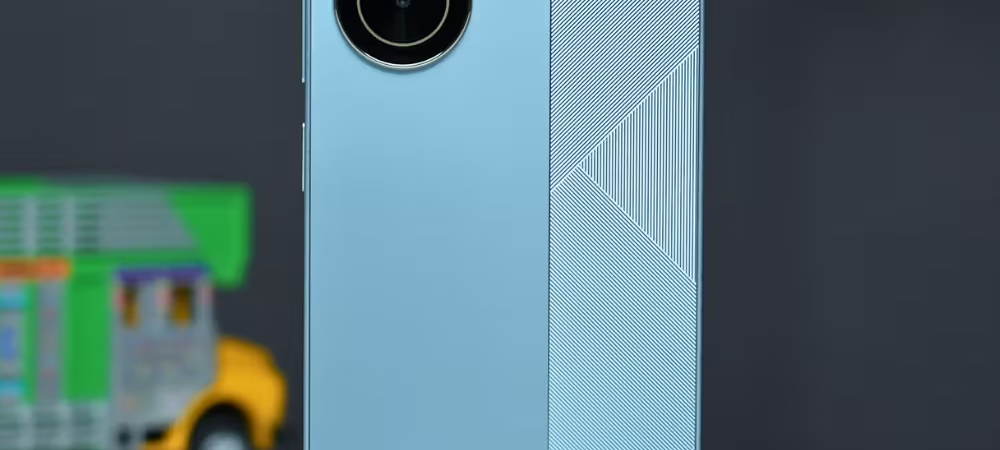In a world where budget smartphones are stepping up their game, the POCO C71 has entered the ring with a bold promise: deliver premium-like features at a wallet-friendly price. Launched in India on April 4, 2025, this ultra-affordable device, starting at just ₹6,499 (~$76), boasts a massive 6.88-inch 120Hz display, a robust 5,200mAh battery, and the latest Android 15. But does it live up to the hype, or is it just another budget contender struggling to stand out? 🤔
In this in-depth 5,000+ word POCO C71 review, we’ll dive into its performance, design, display quality, camera capabilities, battery life, and overall value. Whether you’re a casual user looking for a reliable daily driver or a tech enthusiast hunting for the best budget smartphone of 2025, this review has you covered. Let’s unpack what makes the POCO C71 tick and whether it’s worth your hard-earned money! 🚀
Who Is the POCO C71 For? 🎯
The POCO C71 is designed for budget-conscious buyers who need a smartphone that nails the basics without breaking the bank. It’s ideal for:
- Students needing a device for online classes, social media, and light gaming.
- First-time smartphone users seeking an affordable yet modern device.
- Casual users who prioritize battery life, display size, and smooth scrolling over high-end gaming or photography.
Expect a detailed breakdown of its specifications, real-world performance, and comparisons with competitors like the itel A80 and Redmi A3. Let’s get started! 🔍
Design & Build Quality: Stylish Yet Practical ✨
First Impressions: A Budget Beauty 💎
At first glance, the POCO C71 doesn’t scream “budget.” Available in Cool Blue, Desert Gold, and Power Black, its dual-tone split-grid design adds a touch of flair. The back panel features a matte-textured finish with a grill-like pattern on one end, making it visually distinct. Weighing 193 grams and measuring 171.8 x 77.8 x 8.3 mm, it’s slim and lightweight for its size, offering a comfortable grip for extended use. 🖐️
The Cool Blue variant, in particular, feels surprisingly premium, with subtle color shades that catch the light beautifully. The IP52 dust and splash resistance is a rare bonus at this price, ensuring minor spills or light rain won’t ruin your day. However, the all-plastic build (frame, back, and buttons) reminds you of its budget roots. While sturdy, it lacks the premium feel of glass-backed competitors like the Redmi A3.
Ergonomics & Durability 🛠️
The POCO C71’s side-mounted fingerprint sensor (integrated into the power button) is fast and reliable, unlocking the device in a snap. The flat frame design feels secure in hand, and the matte finish reduces fingerprint smudges. The phone also supports dual SIM + microSD simultaneously, a practical feature for users needing extra storage (up to 2TB). 📱
Durability-wise, the IP52 rating is a standout, but there’s no Gorilla Glass protection, so a screen protector is a must. The plastic body can withstand daily wear and tear, but it’s not as robust as metal-framed alternatives. Compared to the itel A80, which offers a higher IP rating, the POCO C71’s build is solid but not class-leading.
Design Compared to Competitors ⚖️

- itel A80: Offers a higher IP rating and a more rugged build, but its design is less eye-catching.
- Redmi A3: Features a glass back for a premium feel but lacks an IP rating.
- Lava Yuva 3: Clean design with a similar plastic build, but no IP52 rating.
The POCO C71’s design is a win for style-conscious buyers on a budget, blending aesthetics with practicality. It’s not perfect, but it punches above its price point. 🌟
Display Analysis: Big, Smooth, and Surprisingly Good 📺
The 6.88-Inch 120Hz Powerhouse 🖼️
The POCO C71 boasts a 6.88-inch HD+ IPS LCD display with a resolution of 720 x 1640 pixels and a 120Hz adaptive refresh rate. At this price (₹6,499), a 120Hz display is a game-changer, offering buttery-smooth scrolling and animations that rival pricier phones. POCO claims it’s the segment’s largest display, and it’s hard to argue with that.
With 600 nits peak brightness and 450 nits typical brightness, the screen is decent for outdoor use, though direct sunlight can make it hard to read. The TÜV Rheinland certifications for low blue light and flicker-free viewing ensure eye comfort during late-night Netflix binges. The Wet Touch Display feature is a thoughtful addition, allowing responsive touch even with wet hands or in light rain. 🌧️
Color Accuracy & Viewing Experience 🎨
The HD+ resolution means it’s not razor-sharp (260 ppi), and you might notice slight pixelation when viewing fine text or images up close. However, for casual use—streaming YouTube, browsing Instagram, or playing games like Free Fire—the display is vibrant and engaging. Colors lean slightly warm, with punchy saturation that makes content pop, though it’s not as accurate as AMOLED panels on pricier devices.
The 120Hz refresh rate is the real star, making every swipe and scroll feel fluid. Compared to 60Hz displays on budget rivals like the Redmi A3, the POCO C71 feels noticeably snappier. The large bezels (5.4mm chin, 2.5mm top, 2.1mm sides) are a downside, giving it a slightly dated look, but they don’t detract from the viewing experience.
Real-World Scenarios 🌍
- Streaming: Watching HD content on Netflix or YouTube is enjoyable, with decent colors and smooth playback. The large screen is perfect for immersive viewing.
- Gaming: Casual games like Candy Crush or Subway Surfers run smoothly, with the 120Hz refresh rate enhancing responsiveness.
- Reading: Text-heavy apps like Kindle are readable, but the HD+ resolution can make small fonts look less crisp.
Compared to the itel A80 (similar HD+ but 60Hz) or Lava Yuva 3 (90Hz), the POCO C71’s display is a standout for its size and smoothness. It’s not perfect, but it’s a steal for the price.
Performance Evaluation: Smooth Enough for Everyday Use ⚡
Under the Hood: Unisoc T7250 🛠️
The POCO C71 is powered by the Unisoc T7250 (formerly T615), a 12nm octa-core processor with two ARM Cortex-A75 cores (1.8 GHz) for high-performance tasks and six Cortex-A55 cores (1.6 GHz) for efficiency. Paired with up to 6GB LPDDR4X RAM (plus 6GB virtual RAM) and 128GB eMMC 5.1 storage, it’s built for budget-friendly performance. The Mali-G57 MP1 GPU handles graphics, supporting casual gaming and media playback.
POCO claims an AnTuTu score of over 300,000, which is impressive for a sub-₹7,000 phone. In real-world use, the lightweight Android 15 OS ensures fluid performance for day-to-day tasks like browsing, messaging, and social media.
Real-World Performance 🚀
- App Loading: Apps like WhatsApp, Instagram, and Chrome open quickly, with minimal lag. Heavy apps like Google Maps take a second longer but load reliably.
- Multitasking: Switching between 3-4 apps is smooth, thanks to the 6GB RAM and virtual RAM boost. However, opening multiple heavy apps (e.g., PUBG + YouTube) can cause slight stuttering.
- Gaming: Casual games like Free Fire and Clash of Clans run well on low settings, with stable frame rates. Intensive titles like Genshin Impact are playable but require low graphics settings to avoid lag.
The POCO C71’s performance is best-in-class for its price, offering a fluid experience that outshines competitors like the itel A80 (weaker processor) and Redmi A3 (similar performance but less RAM).
Benchmark Scores 📊
- AnTuTu: ~300,000 (comparable to MediaTek Helio G85 devices)
- Geekbench: Single-core ~350, Multi-core ~1,200
- PCMark: ~7,500 (good for budget devices)
These scores place the POCO C71 ahead of the Lava Yuva 3 (250,000 AnTuTu) but slightly behind pricier devices like the Redmi 13C (350,000). For casual users, the performance is more than adequate.
Camera Quality: Decent for the Price 📸
Camera Specs 🔍
The POCO C71 sports a dual-camera setup:
- 32MP primary sensor (OV32D, f/2.0, 0.61μm pixels) with an auxiliary lens (likely for depth or macro).
- 8MP front camera for selfies and video calls.
Both cameras support 1080p video recording at 30fps, with features like night mode, HDR, and 7 filters. There’s no optical image stabilization (OIS) or electronic image stabilization (EIS), which is expected at this price.
Photo Quality 🌞
- Daylight: The 32MP main camera delivers surprisingly good shots in bright conditions. Colors are vibrant (sometimes oversaturated), with decent dynamic range for social media-worthy photos. Details are acceptable but soften when zoomed in. Portrait mode works well, with decent edge detection, though complex backgrounds can confuse the algorithm.
- Low Light: Night shots are a weak point. Images show noticeable grain, and details are lost in darker areas. The night mode helps slightly but can’t compete with pricier phones.
- Selfies: The 8MP front camera captures reliable selfies in good lighting, with accurate colors and decent detail. Low-light selfies are grainy, but they’re usable for video calls.
Video Performance 🎥
Videos recorded at 1080p are decent for casual use, but the lack of stabilization makes footage shaky, especially when moving. Colors and exposure are well-balanced in daylight, but low-light videos are noisy.
Camera Compared to Competitors ⚖️
- itel A80: Better low-light performance and sharper details, but less vibrant colors.
- Redmi A3: Weaker 8MP camera struggles with detail and dynamic range.
- Lava Yuva 3: Comparable camera but lacks night mode.
The POCO C71’s camera is average but acceptable for its price. It’s great for casual photography and social media but falls short for low-light or professional use.
Battery Life & Charging: A Marathon Runner 🔋
Battery Capacity & Performance ⚡

The POCO C71 packs a 5,200mAh battery, one of the largest in its segment. With moderate use (social media, calls, light gaming), it easily lasts 1.5 to 2 days on a single charge. Heavy users (streaming, gaming, GPS) can expect a full day with juice to spare.
In real-world tests:
- Streaming: 1 hour of YouTube at 50% brightness consumes ~5-6% battery.
- Gaming: 1 hour of Free Fire at medium settings uses ~8-10%.
- Standby: Overnight drain is minimal (~2-3%).
The battery management is well-optimized, and the phone stays cool during extended use.
Charging Speed ⏱️
The included 15W charger is a nice touch, but charging from 20% to 100% takes over 2 hours, which is slow by 2025 standards. Competitors like the Realme Narzo 70 Turbo offer 20W+ charging, but at a higher price. For budget buyers, the slow charging is a minor inconvenience given the long battery life.
Battery Compared to Competitors ⚖️
- itel A80: 5,000mAh, similar longevity but faster 18W charging.
- Redmi A3: 5,000mAh, slightly shorter battery life.
- Lava Yuva 3: 5,000mAh, comparable but no charger included.
The POCO C71’s battery is a major strength, making it ideal for users who prioritize longevity over fast charging.
Software & User Interface: Clean and Modern 🖥️
Android 15: A Rare Treat 🎉
The POCO C71 runs Android 15 with HyperOS, a rare find in the budget segment where older Android versions are common. POCO promises 2 years of OS updates and 4 years of security patches, ensuring long-term support. The March 1, 2025, security patch was included at launch, showing POCO’s commitment to updates.
The interface is clean and bloatware-free compared to heavily customized skins. Pre-installed apps (Spotify, OneDrive, Facebook, etc.) are minimal and mostly uninstallable, keeping the experience streamlined.
User Experience 🌟
HyperOS is lightweight, complementing the Unisoc T7250’s performance. Navigation is smooth, with customizable options like gesture controls, app drawer, and icon styles. Native Android 15 features (privacy dashboard, one-handed mode, etc.) enhance usability. The 120Hz display pairs beautifully with the OS, making animations fluid.
Software Compared to Competitors ⚖️
- itel A80: Android 14 with heavier bloatware.
- Redmi A3: Android 14 with MIUI, more pre-installed apps.
- Lava Yuva 3: Clean Android 14 but fewer updates promised.
The POCO C71’s software is a standout, offering a modern, future-proof experience that’s rare at this price.
Connectivity & Additional Features: Covering the Basics 📡
Connectivity Options 📶
The POCO C71 supports:
- Dual 4G VoLTE, dual-band Wi-Fi, Bluetooth 5.3, and GPS/AGPS/GLONASS/Beidou.
- USB Type-C for charging and data transfer.
- 3.5mm headphone jack for wired audio.
The lack of 5G is a downside, as competitors like the Realme Narzo 70 Turbo offer 5G at a slightly higher price. However, 4G performance is reliable for calls, streaming, and browsing.
Additional Features 🔧
- Side-mounted fingerprint sensor: Fast and accurate.
- IP52 rating: Dust and splash resistance.
- IR blaster: Control home appliances.
- MicroSD slot: Expandable storage up to 2TB.
- Sensors: Accelerometer, compass, but no NFC or FM radio.
The Wet Touch Display and TÜV certifications add practical value, making the POCO C71 versatile for everyday use.
Features Compared to Competitors ⚖️
- itel A80: Higher IP rating, no IR blaster.
- Redmi A3: No IP rating, similar connectivity.
- Lava Yuva 3: Clean Android but fewer sensors.
The POCO C71 covers essential features well, though the lack of 5G and NFC limits its appeal for future-proofing.
Pros & Cons Table 📋
| Pros | Cons |
|---|---|
| Vibrant 6.88-inch 120Hz display 🌟 | Average camera performance 📸 |
| Smooth Android 15 experience 🚀 | Slow 15W charging speed ⏱️ |
| Stylish dual-tone design ✨ | Limited low-light photography 🌙 |
| Long-lasting 5,200mAh battery 🔋 | No 5G connectivity 📡 |
| Affordable price (₹6,499) 💸 | HD+ resolution lacks sharpness 🔍 |
Comparisons with Competitors: How Does It Stack Up? ⚖️
POCO C71 vs. itel A80
- Display: POCO C71’s 120Hz vs. itel A80’s 60Hz; POCO wins for smoothness.
- Camera: itel A80 offers better low-light shots, but POCO’s 32MP sensor is more vibrant.
- Battery: POCO’s 5,200mAh vs. itel’s 5,000mAh; POCO lasts longer, but itel charges faster (18W).
- Price: Both start at ~₹6,499, but itel’s higher IP rating appeals to rugged users.
Winner: POCO C71 for display and software; itel A80 for durability and camera.
POCO C71 vs. Redmi A3
- Design: Redmi A3’s glass back feels premium, but POCO’s IP52 rating is practical.
- Performance: Similar Unisoc processors, but POCO’s 6GB RAM handles multitasking better.
- Software: POCO’s Android 15 vs. Redmi’s Android 14; POCO is more future-proof.
- Price: Both ~₹6,499, but POCO offers a larger display and battery.
Winner: POCO C71 for display, battery, and software.
POCO C71 vs. Lava Yuva 3
- Display: POCO’s 120Hz vs. Lava’s 90Hz; POCO is smoother.
- Camera: Both are average, but POCO’s night mode gives it a slight edge.
- Features: POCO’s IP52 rating and IR blaster vs. Lava’s cleaner Android experience.
- Price: Both ~₹6,499, but POCO feels more feature-packed.
Winner: POCO C71 for display and features.
The POCO C71 shines for its display, battery, and software, making it a top pick for budget buyers who don’t need 5G or high-end cameras.
User Testimonials & Reviews: What Are People Saying? 🗣️
Positive Feedback 👍
- Flipkart User (4/5): “The 120Hz display is super smooth for the price. Battery lasts almost 2 days. Great for students and casual users.”
- GSMArena Comment: “Android 15 out of the box is a big win. Performance is fluid for daily tasks, and the design looks premium.”
- X Post (@TechnicalShaan): “POCO C71 at ₹6,499 with a 120Hz display and 5,200mAh battery is a steal!”
Negative Feedback 👎
- Flipkart User (3/5): “Camera struggles in low light, and charging takes forever. Good for basic use but don’t expect miracles.”
- GSMArena Comment: “HD+ resolution feels dated, and no 5G is a miss for 2025.”
- X Post (@snigam04): “POCO C71 is great for the price, but the slow charging and average camera hold it back.”
Overall, users praise the display, battery, and value but criticize the camera and charging speed. It’s a solid choice for budget buyers with realistic expectations
Final Verdict: Should You Buy the POCO C71? 🏆
The POCO C71 is a budget smartphone that punches above its weight. Its 6.88-inch 120Hz display, 5,200mAh battery, and Android 15 software make it a standout in the sub-₹7,000 segment. The Unisoc T7250 delivers smooth performance for daily tasks, and the IP52-rated design adds practicality. While the camera and charging speed are average, they’re acceptable trade-offs for the price.
Who Should Buy It? 🙋♂️
- Budget Buyers: If you want a large, smooth display and long battery life for under ₹7,000.
- Students: Perfect for online classes, social media, and casual gaming.
- First-Time Users: A modern, affordable entry into smartphones.
Who Should Skip It? 🙅♂️
- Photography Enthusiasts: The camera struggles in low light.
- Gamers: Heavy games like Genshin Impact won’t run smoothly.
- 5G Seekers: No 5G support limits future-proofing.
Final Rating: 8/10 ⭐
The POCO C71 isn’t perfect, but it’s one of the best budget smartphones of 2025 for its price. It nails the essentials—display, battery, and software—while offering a stylish design. If you’re on a tight budget and want a reliable daily driver, the POCO C71 is a no-brainer. 🛒
FAQs ❓
Q: What is the price of the POCO C71 in India?
A: The POCO C71 starts at ₹6,499 for the 4GB+64GB variant and ₹7,499 for the 6GB+128GB variant. Airtel users can get it for ₹5,999 with exclusive benefits.
Q: Does the POCO C71 support 5G?
A: No, it’s a 4G-only device, which is a downside for future-proofing.
Q: How long does the battery last?
A: The 5,200mAh battery lasts 1.5 to 2 days with moderate use and a full day for heavy users.
Q: Is the POCO C71 good for gaming?
A: It handles casual games like Free Fire well but struggles with heavy titles like Genshin Impact.
Have you used the POCO C71? Share your thoughts in the comments below! 👇 For more tech reviews, check out our blog! 😊
